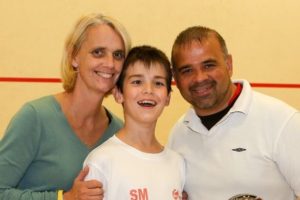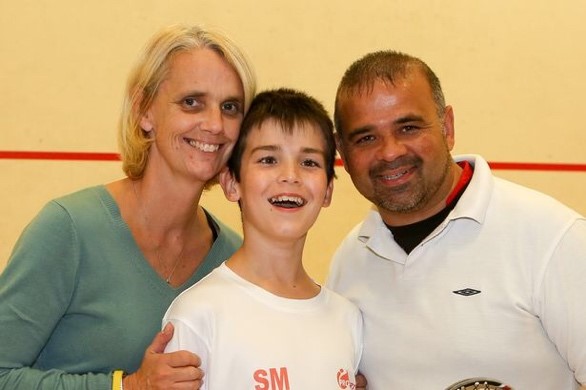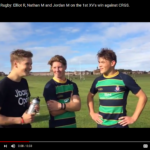#SunshineForSumner – Ellie Hewes
As some of you probably know, I play squash around the country. However, I was startled when I heard that one member of the Malik family (a family who too go round the country on the squash circuit) had developed a rare form of brain tumour, two years ago. The family had been noticing that he kept missing the squash ball and that his general health was deteriorating. They took him to the doctors who put it down as a virus but within a couple of weeks, when taken to A&E, they realised it was something completely different.
Sumner is a keen squash player and he is always making jokes, smiling and laughing. He is in a family of eight and lives in Sussex with his parents, two older brothers called Curtis and Perry and an older sister called Torrie. He is also in a triplet (of whom he is the youngest) consisting of his identical brothers: Heston and Bailey.
The brain tumour he has is known as Diffuse Intrinsic Pontine Giloma. It is a terminal form of a paediatric brain tumour. There is no known cure. Sadly out of everyone who has been diagnosed with it, all of them have ended with a loss. We really want to change this for Sumner! There are lots of hospitals and doctors out there who are looking for treatment but it takes a lot of money. Research is being carried out all across the world for Sumner and many others who hold this aggressive brain tumour.
DIPG is the second most common primary type of brain tumour and it is high graded; especially within children. A primary brain tumour is a tumour that has come about only through the brain and not as an effect due to a problem somewhere else in the body. DIPG is high graded due to the speed at which it grows at and can spread to other parts of the body such as the spinal cord. It is sometimes referred to as malignant or cancerous tumour.
The disease originates from the pons. These are in the deep, lower part of the brain, within the brain stem. It is responsible for many critical aspects of human life that we probably do not even think about such as breathing, sleeping, blood pressure, balance and sight. To minimise the growth of the tumour, surgery can be implemented. However, this is only if in the right location. Sometimes surgery cannot be permitted due to the wrong location that cannot yet be operated on. Radiotherapy can also be used as well as chemotherapy in order to shrink the tumour. Within this time, steroids may also be taken in order to make your child stronger within these weekly doses.
Can you imagine going through this for two years? Can you imagine going through all of this at ten years of age? I know I could not. Every time I see him, he has a smile on his face. Every time I see him, he is laughing. Every time I see him, it reminds me of how lucky I am. How lucky I am with the things that I have and how I take it for granted. He and his family have to live with this brain tumour over them every day but they don’t let it simply stop their lives, they carry on. They take every single opportunity they can get with Sumner. They take every opportunity to laugh and be happy. They are an inspiration and this young boy is no other than a role model that everyone should learn from. I personally do not think I could do it, both as Sumner and as his family have been. His dad said:
“It’s been 13 months since we got the news no parent ever wants to hear – that our child has a terminal illness. After Sumner was diagnosed with DIPG (diffuse intrinsic pontine glioma), doctors told us he had nine months tops and the best thing for us to do was take him home and make memories. Even though we were told there is no known cure for our son’s rare and terminal brain tumour, we were determined not to give up on him and started researching alternative treatments available outside the NHS.”
There is still hope though! The family have been appointed and have discovered neurosurgeon Professor Steven Gill of the Bristol Royal Hospital for Children. He uses revolutionary technology called Convection Enhanced Delivery (CED) which delivers the drug directly to the brain using small tubes called micro-catheters inserted into the brain, stopping toxic drugs from entering the blood stream through the brain blood wall membrane. Scans have shown that the tumour is shrinking!
He has recently started secondary school; a milestone not thought to be reached, and continues to play squash. He continues to make great progress but still needs help.
If you would like to find out more:

www.sunshine4sumner.com AND https://www.justgiving.com/crowdfunding/sunshine4sumner OR TEXT SUMN18 TO 70070















Post Comment
You must be logged in to post a comment.